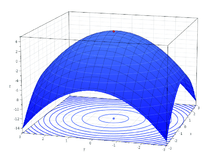Artificial bee colony algorithm
In computer science and operations research, the artificial bee colony algorithm (ABC) is an optimization algorithm based on the intelligent foraging behaviour of honey bee swarm, proposed by Karaboga in 2005.[1]
Algorithm
In the ABC model, the colony consists of three groups of bees: employed bees, onlookers and scouts. It is assumed that there is only one artificial employed bee for each food source. In other words, the number of employed bees in the colony is equal to the number of food sources around the hive. Employed bees go to their food source and come back to hive and dance on this area. The employed bee whose food source has been abandoned becomes a scout and starts to search for finding a new food source. Onlookers watch the dances of employed bees and choose food sources depending on dances. The main steps of the algorithm are given below:
- Initial food sources are produced for all employed bees
- REPEAT
- Each employed bee goes to a food source in her memory and determines a neighbour source, then evaluates its nectar amount and dances in the hive
- Each onlooker watches the dance of employed bees and chooses one of their sources depending on the dances, and then goes to that source. After choosing a neighbour around that, she evaluates its nectar amount.
- Abandoned food sources are determined and are replaced with the new food sources discovered by scouts.
- The best food source found so far is registered.
- UNTIL (requirements are met)
In ABC, a population based algorithm, the position of a food source represents a possible solution to the optimization problem and the nectar amount of a food source corresponds to the quality (fitness) of the associated solution. The number of the employed bees is equal to the number of solutions in the population. At the first step, a randomly distributed initial population (food source positions) is generated. After initialization, the population is subjected to repeat the cycles of the search processes of the employed, onlooker, and scout bees, respectively. An employed bee produces a modification on the source position in her memory and discovers a new food source position. Provided that the nectar amount of the new one is higher than that of the previous source, the bee memorizes the new source position and forgets the old one. Otherwise she keeps the position of the one in her memory. After all employed bees complete the search process, they share the position information of the sources with the onlookers on the dance area. Each onlooker evaluates the nectar information taken from all employed bees and then chooses a food source depending on the nectar amounts of sources. As in the case of the employed bee, she produces a modification on the source position in her memory and checks its nectar amount. Providing that its nectar is higher than that of the previous one, the bee memorizes the new position and forgets the old one. The sources abandoned are determined and new sources are randomly produced to be replaced with the abandoned ones by artificial scouts.
Application to real-world problems
Since 2005, D. Karaboga and his research group have been studying the ABC algorithm and its applications to real world problems. In 2010, Hadidi et al. employed an Artificial Bee Colony (ABC) Algorithm based approach for structural optimization.[2] In 2011, Y. Zhang et al. employed the ABC for various tasks, including multi-level thresholding,[3] MR brain image classification,[4] and face pose estimation.[5] Artificial Bee Colony (ABC) algorithm has been used for nanoelectronic based phase-locked loop (PLL) optimization by O. Garitselov, S. P. Mohanty, and E. Kougianos to speedup physical design optimization.[6]
See also
- Bees algorithm
- Evolutionary computation
- Intelligent Water Drops
- Swarm intelligence
- Particle Swarm Optimization
- Evolutionary multi-modal optimization
References
- ↑ D. Dervis Karaboga, An Idea Based On Honey Bee Swarm for Numerical Optimization, Technical Report-TR06,Erciyes University, Engineering Faculty, Computer Engineering Department 2005.
- ↑ Ali Hadidi, Sina Kazemzadeh Azad, Saeid Kazemzadeh Azad, Structural optimization using artificial bee colony algorithm, 2nd International Conference on Engineering Optimization, 2010, September 6 – 9, Lisbon, Portugal.
- ↑ Yudong, Zhang; Lenan, Wu (2011). "Optimal multi-level Thresholding based on Maximum Tsallis Entropy via an Artificial Bee Colony Approach". Entropy 13 (4): 841–859.
- ↑ Yudong, Zhang; Lenan, Wu; Shuihua, Wang (2011). "Magnetic Resonance Brain Image Classification by an Improved Artificial Bee Colony Algorithm". Progress in Electromagnetics Research - Pier 116: 65–79.
- ↑ Y. Zhang, L. Wu, Face Pose Estimation by Chaotic Artificial Bee Colony, International Journal of Digital Content Technology and its Applications, vol. 5, no. 2, (2011), pp. 55-63
- ↑ O. Garitselov, S. P. Mohanty, and E. Kougianos, “Accurate Polynomial Metamodeling-Based Ultra-Fast Bee Colony Optimization of a Nano-CMOS PLL”, Special Issue on Power, Parasitics, and Process-Variation (P3) Awareness in Mixed-Signal Design, Journal of Low Power Electronics (JOLPE), Volume 8, Issue 3, June, 2012, pp. 317--328.
External links
| |||||||||||||||||||||||||||||||||||||||||||||||||||||||||||||||||||||||||||||||||||||||||||||||||||||||||||||
